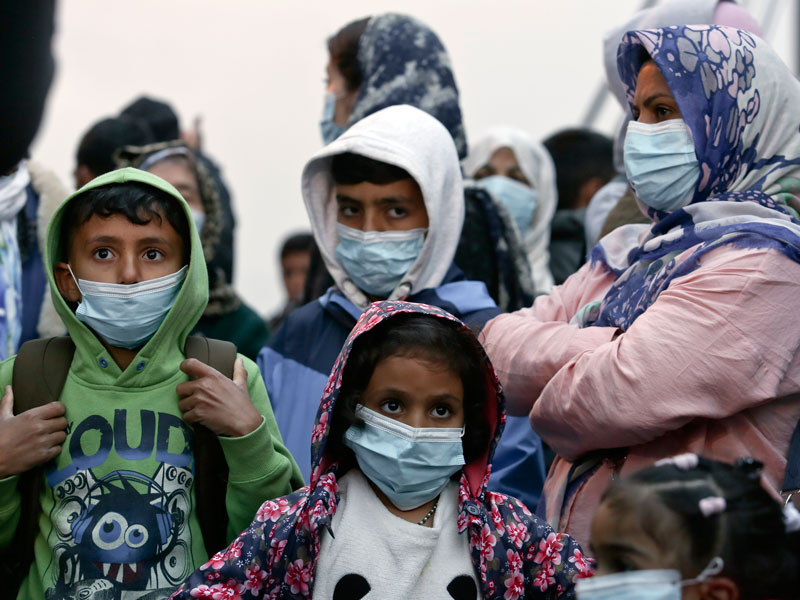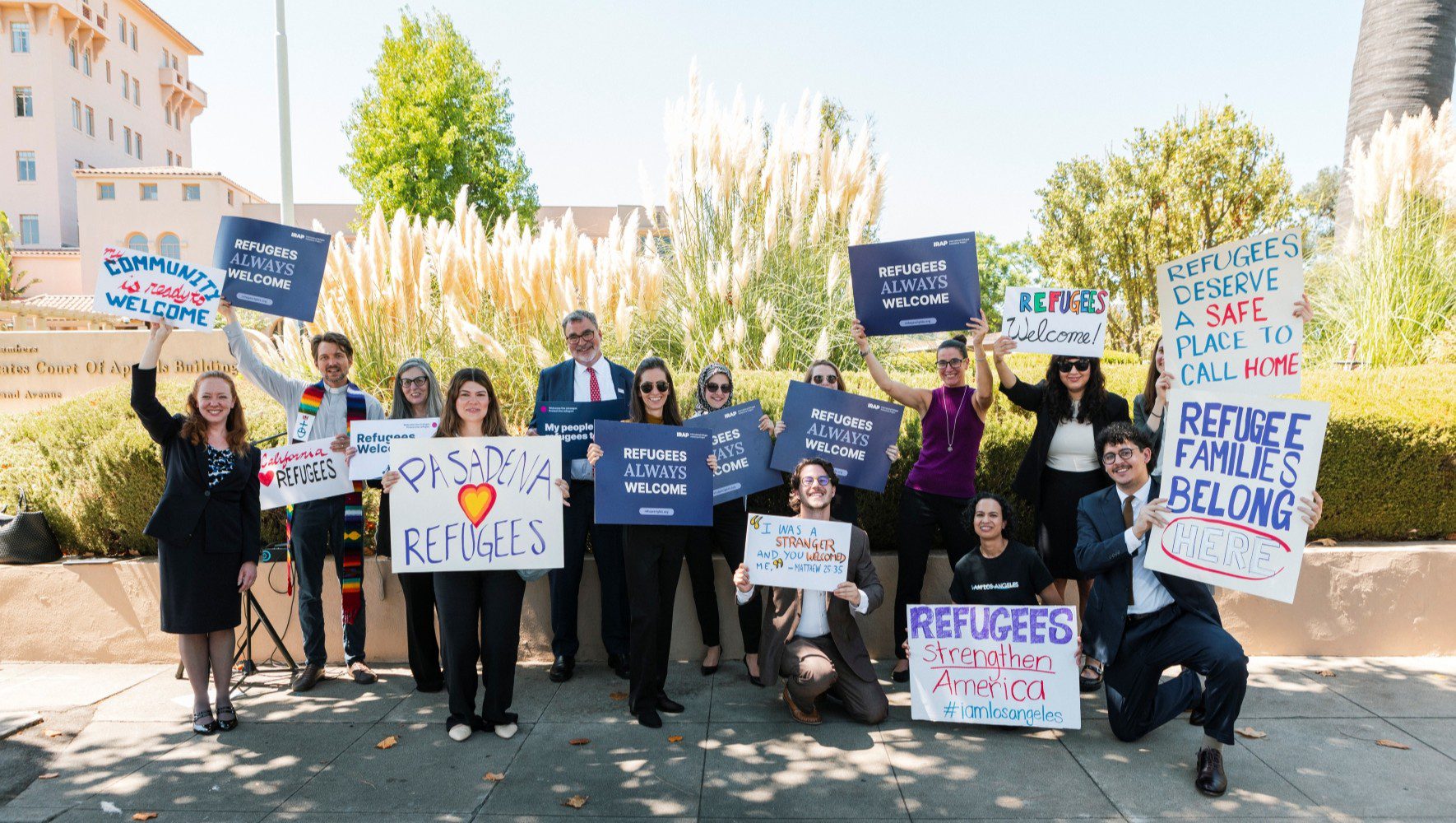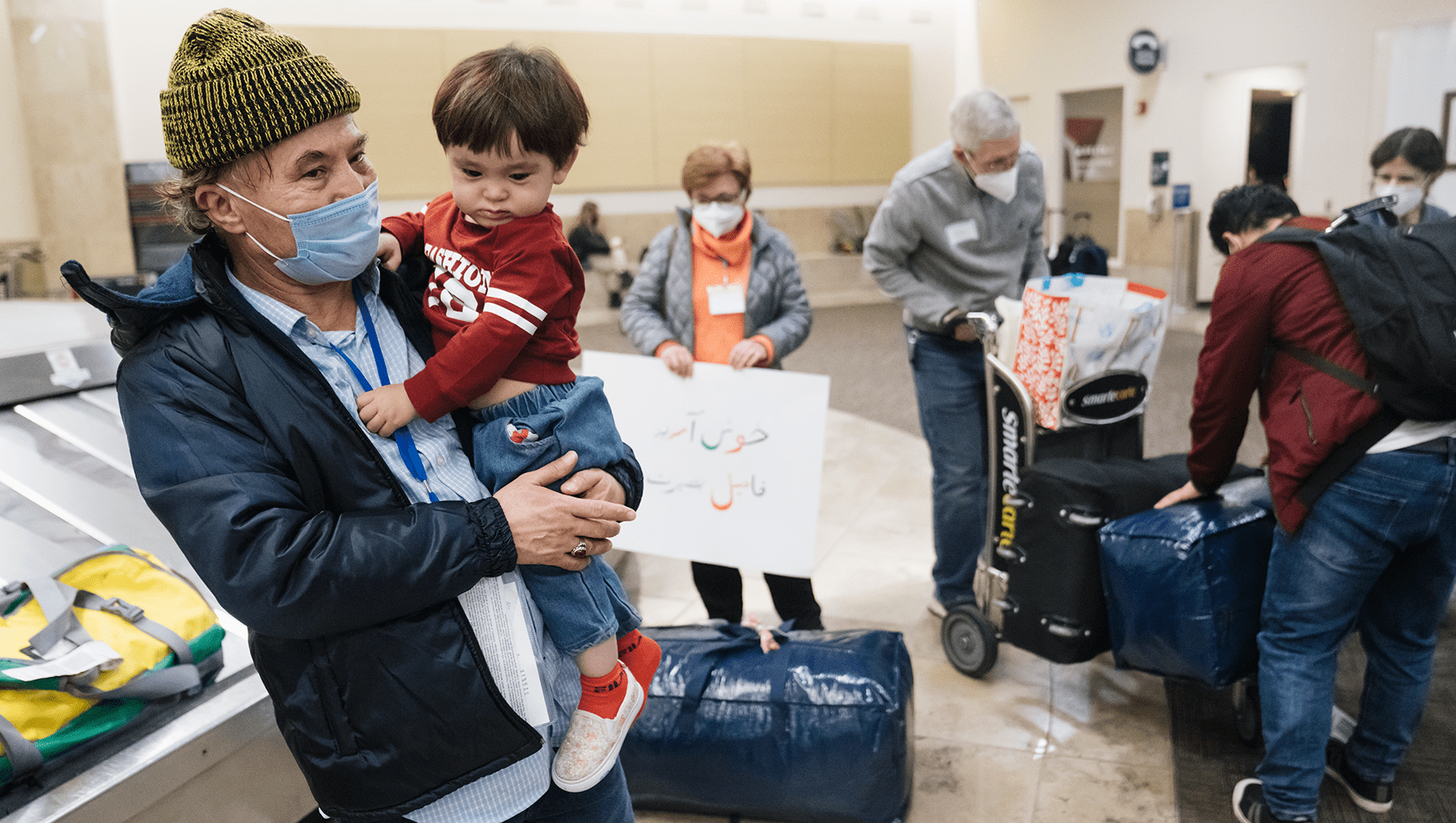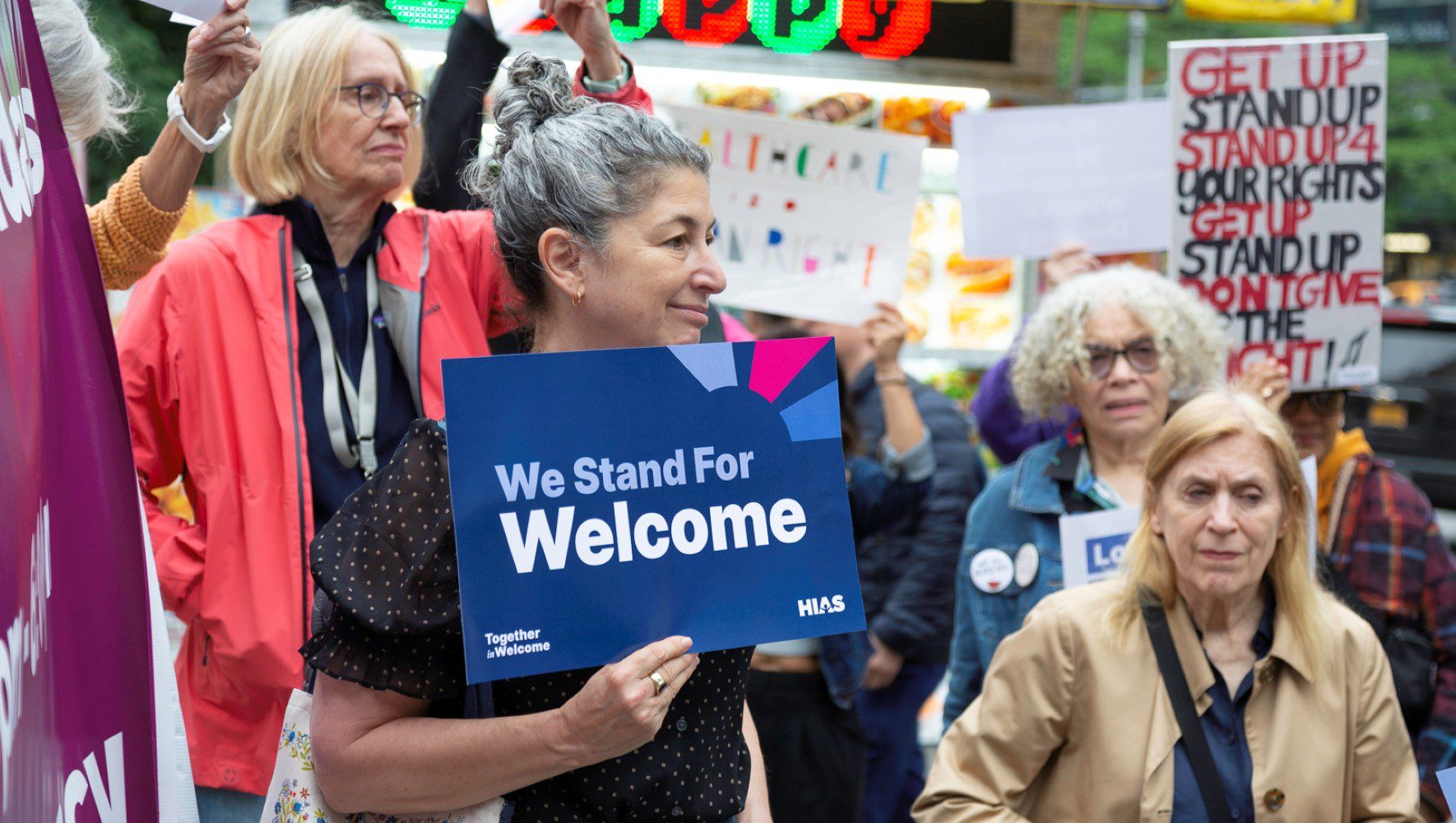A Global Perspective on the Modern Perils of Seeking Asylum
May 05, 2020

Refugees from the Moria camp in Lesvos wearing masks to prevent the spread of the coronavirus, wait for a bus after their arrival on May 4, 2020 in Athens, Greece.
(Milos Bicanski/Getty Images)
Originally published in Human Rights, Vol. 45, No. 2, by the American Bar Association. Reproduced with permission.
In late February 2020, Turkey opened its western border to potentially allow millions of refugees into Europe, while, simultaneously, a U.S. federal court blocked a cruel policy of forcing 60,000 asylum seekers to wait for American asylum processing in Mexico, causing confusion and crowds at the southern border. These actions are different in scale and context, but the mirrored images of humanitarian distress, chaotic borders, and harsh entry policies have important similarities. Each of these elements is among a series of trends in how major developed countries are responding to refugees around the world. Ultimately, in the fight between well-resourced nation states and those who flee from persecution, refugees are losing nearly all of their rights for an ever-narrowing chance at safety.
In response, human rights and asylum lawyers in the United States, the European Union (EU), and elsewhere have been working overtime to assist people in navigating asylum systems that are complex, slow, and opaque. Long-time advocates have been joined by new volunteers and supporters to help refugees with little political power find avenues for legal status amid a public narrative that often portrays them in the harshest light possible and treats them accordingly.
HIAS—founded in the 1880s as the Hebrew Immigrant Aid Society—is the oldest refugee resettlement agency in the United States and is one of many organizations that represent asylum seekers in the United States, including along both sides of the southern border. HIAS has extensive legal and human rights programs protecting refugees in 16 countries. These include the United States, Mexico, and Greece—where HIAS lawyers represent people with asylum claims, advocate for access to human rights, and use litigation to secure safety for refugees. (Note the recent cases of IRAP v. Trump (2017) and HIAS v. Trump (2019), both related to aspects of travel bans that exclude refugees from the United States). Last year, HIAS directly served nearly 750,000 people worldwide through a variety of rights-focused services.
In examining the global context of migration, related government response, and legal advocacy to secure rights, important trends emerge that highlight the fragility of the international human rights system. Among these include the impacts of ongoing conflict and related political maneuvering, the need for constant reaffirmation of human rights norms, and the obstacles individuals fleeing for their lives face when they come to the boundaries of state sovereignty.
Restrictive Refugee Policies Can Actually Generate Humanitarian Crises
Ahmed is a tall young man in his late teens. He stands, arms folded, leaning casually back as he talks to us, one leg jutting forward. He has the air of someone in motion, with a place to be. Gradually, the conversation shifts from niceties to more specific questions on our minds. “I am from Syria. My family all died in the bombings. Now I’m here with my little brother. I want to get to my cousins in Germany. Do you think that’s going to happen? They can’t keep us here like this. It’s not right.” His asylum claim is pending, but the government has deprioritized many cases for later this year, and HIAS and its partners must resort to advocacy for a more functional overall system. There is no easy answer for Ahmed.
Past Ahmed’s shoulder, miles of olive groves spill over rolling hills in the Eastern Aegean island of Lesvos. Grouped at the base of the trees are thousands of canvas tents that house nearly 20,000 refugees—most from Syria, Iraq, and Afghanistan. Barbed wire and fencing marks the official camp, where places for around 3,000 people were overcrowded several years ago. There is no school, access to sanitation is inadequate, trash piles up in dirt streets, and the only “safe area” for unaccompanied children is left unguarded at night.
This is the edge of Europe—a territory with some of the most protective human rights law systems in the world and an active judiciary willing to enforce them. Even before recent events, the conditions have been overcrowded and unsanitary for years. In effect, EU countries have “eternalized” (or pushed out) their border to the Greek Islands while reducing the ability for refugees to move on to other countries within the union. Greece’s relatively right-wing government has little incentive to provide appropriate care for a population that they seem to be saddled with for a long time.
In recent days, as Turkey pressures the EU to assist in its Syria campaign, or accept more refugees, a former tepid welcome has turned into outright hostility by locals, Greek authorities, and EU countries alike. News reports have surfaced of Greek authorities stripping refugees of clothes and a mixture of authorities and vigilantes blocking boats and patrolling borders.
According to the International Organization for Migration’s Missing Migrant Project, in 2019, nearly 1,900 people drowned in the Mediterranean while trying to get to Europe. If they had any chance at a safe and productive life at home, they would stay. If they were allowed to walk across a land border, they would do so. If they were permitted a visa to board an airplane, they would take it. Instead, migration policies force them to pay smugglers to take them on dangerous journeys that many do not survive. As formal routes continue to close, the level of desperation will only increase.
When you join (a) policies that prevent refugee movement within the EU, (b) dis-incentivized arrival countries, and (c) the realities of ongoing wars and long lasting human rights crises, you create a scenario in which populations in arrival centers can only grow and potentially remain for extended periods of time. This manifests in mounting frustration of local populations and alarmingly poor care of refugees. In essence, the EU has manufactured an environment that—rather than safeguarding basic rights—almost guarantees human rights violations.
The Global Picture: The Wrong Moment to Back Away from International Cooperation
Ahmed is one of the over 70 million forced migrants in the world today, 30 million of whom are living outside their home country to seek safety from extreme violence and persecution. According to UN Refugee Agency numbers for 2018, Turkey, Pakistan, and Uganda host the largest numbers of refugees, at 3.7 million, 1.4 million, and 1.2 million people, respectively. In that same year, the United States, Germany, and France saw 254,000, 162,000, and 114,500 asylum claims, respectively.
In the same time-period, only 593,800 refugees were able to return home voluntarily. While UNHCR identified 1.4 million refugees in need of resettlement to a third country, only 81,300 spots were made available. Of those, the United States admitted only 22,800 people, which was a historic low until the number was dropped even further to an 18,000-person ceiling for 2020.
This is all just numbers; of more importance is the story the numbers tell us. What we know is with more people fleeing for their lives, fewer and fewer paths to permanent safety exist. We know that international cooperation is necessary if we want to guarantee even a modicum of human rights for these refugees. We also know that the American role in supporting refugees is relatively small in comparison to countries bordering major crises. So why are refugees and asylum seekers coming to the United States treated with such fear, suspicion, and contempt?
Modern American Asylum Policy is Abusive and Doggedly Misses the Bigger Picture
The United States received a quarter of a million asylum claims in 2018. By the end of that year, the country had a population of 327 million people, according to the U.S. census population tracker. That means that in 2018, asylum seekers represented just 0.08 percent of the total U.S. population. In contrast, one in six people in Lebanon is a refugee, due to the country’s border with Syria. The United States is one of the most powerful countries in the world with a massive economy and the capacity to handle much more than a 0.08 percent population change in one year with dignity, professionalism, and respect for basic human rights.
Instead, since 2017 the United States has banned Muslim travelers, reduced the refugee resettlement program to approximately 20,000 people per year, imprisoned families seeking safety, separated thousands of children from their parents, forced asylum seekers back across the border with Mexico, pushed neighboring countries into increasing refoulement (illegal deportation back to harm), and now is sending people to be processed in Guatemala, which may not be safe for many.
Like the EU, the United States is pushing out its border processes to Mexico and Central America and using policies that violate human rights as a tactic to reduce migration. For asylum seekers, the impact is horrifying and the avalanche of evidence of appalling conditions seems to do little to reverse government policies. In early 2020, the nonprofit Physicians for Human Rights found that the separation of children from parents at the border with Mexico amounts to torture. At least seven children have died in migration custody between 2018 and 2019 after nearly a decade without a death. Conditions of child detention are reported by attorneys to be deplorable, with overcrowding, lack of access to sanitation, and children caring for other younger children. Human Rights Watch reports that Salvadorans are being abused and sometimes killed after being deported back to their home country. The shocking abuses continue.
While suffering these abuses, this small group of vulnerable newcomers is invoked frequently in alarming terms that imply a security concern of national proportions. The obsessive political focus stokes fear, hatred, and xenophobia, and has been connected by some to mass acts of violence, such as the fall 2018 shooting at the Tree of Life synagogue in Pittsburgh and the fall 2019 shooting at a Walmart in El Paso, Texas.
Of any country in this world, the United States has the capacity to take the lead in finding creative, rights-respecting responses to support people fleeing harm alongside global partners. This would be a display of true American strength.
It is Always Legal to Ask for Asylum
Under our current system of nations, regulation of the border is often seen as an essential function of the state, sometimes part of the proof of statehood itself. In the United States, the EU, and elsewhere, this reality is manifesting in a hyper-implementation of restrictive immigration policies as an exercise of political power and control. There is an escape valve in this armor: a carve-out rule that says it is always legal to seek asylum, no matter how one reaches or crosses a border. Even more, a person who seeks asylum is endowed with clearly articulated rights.
This exception was born into our modern context in the wake of the atrocities of World War II—a moment in which states agreed that it would never again be acceptable to send someone back to a place where they would face violence and persecution.
The right to seek asylum is found in Article 14(1) of Eleanor Roosevelt’s 1948 brainchild—the Universal Declaration of Human Rights—which states “Everyone has the right to seek and to enjoy in other countries asylum from persecution.” From there, the 1951 Refugee Convention codified the definition of an asylum seeker in detail and enumerated their rights. These include rights to education, work, social services, freedom from discrimination, and freedom from retribution based on how a border was crossed. The beauty of the 1951 Convention is its care in outlining the rights a person would need when completely reassembling normalcy after leaving everything behind. These provisions are added to and reinforced by subsequent human rights instruments at the international and regional level, including the 1974 OAU Refugee Convention and the 1984 Cartagena Declaration.
In short, refugees and asylum seekers have clear rights to safety, dignity, and self-actualization. In reality, accessing the minimum of rights often requires a strenuous fight.
Human Rights Advocates Are Crucial in the Fight for Fair Asylum
Under human rights law, an individual is seen as a rights holder, and a state is seen as having duties to respect, protect, and fulfill those rights. Unfortunately, for asylum seekers coming to the U.S. and EU borders, access to human rights seems to be the last priority of the states involved. Every aspect of dignity has to be fought for by the asylum seekers themselves or by their lawyers (if they can access one). Every day, HIAS and our like-minded colleagues go to work to represent individuals like Ahmed who have had to leave their home countries and face impossible challenges. HIAS advocates help them navigate the asylum process, file appeals if their claims are improperly rejected, advocate for better conditions during the process, and litigate to defend access to due process and human rights. This type of representation is crucial because for asylum seekers, legal status can mean the difference between life and death. It is inherently imbalanced for an individual to face the weight of an entire state alone when so much is at stake.
Speaking with Ahmed that day in the Greek refugee camp, it was hard to know what to say. Yes, this situation is completely unfair. It’s unethical, unsafe, and illegal. The only thing we can promise is that HIAS will continue to represent, advocate, and litigate for something better and more rights-compliant. The work is hard and requires the long-term commitment of passionate advocates who are willing to push back against overreaches of state power and potentially devastating administrative errors on a daily basis.
None of us can do this work alone. HIAS and its many partners need your help in championing the basic human rights of asylum seekers and refugees in the face of ongoing attacks from the administration. This can be done in many ways—by highlighting the issue with friends or communities of faith, speaking out against abuses, supporting with your dollars, or even your time. Many organizations, including HIAS, have projects that specifically leverage the strength of pro bono volunteers to secure legal representation for asylum seekers. Join HIAS in standing up for vulnerable people who are just asking for the right to survive in dignity.


